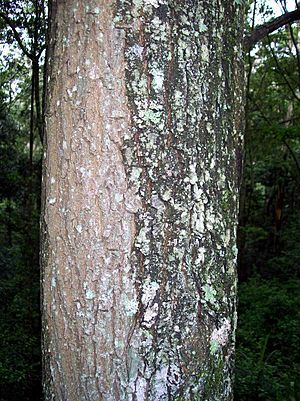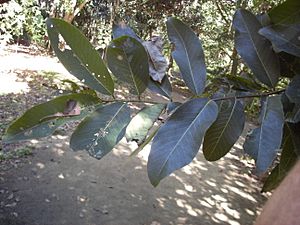Bridelia exaltata facts for kids
Quick facts for kids Bridelia exaltata |
|
|---|---|
 |
|
| Brush ironbark, trunk wet after rain | |
| Scientific classification | |
| Genus: |
Bridelia
|
| Species: |
exaltata
|
Bridelia exaltata, also known as the brush ironbark or scrub ironbark, is a tall tree found in eastern Australia. You can spot it growing in and around drier rainforests, and often near streams. It likes to grow alongside another tree called the Black Bean. This tree can be found from Seal Rocks, New South Wales all the way up to Maryborough, Queensland, sometimes as high as 600 metres above sea level.
The name Bridelia honors a moss expert named Samuel Elisée Bridel-Brideri. The word exaltata means "exalted" or "tall," which makes sense because these trees can grow very high!
Discover the Brush Ironbark Tree
This is a medium-sized tree, but it can sometimes grow really tall, reaching up to 35 metres (about 115 feet)! Its trunk can be as wide as 90 cm (about 3 feet) across. The trunk is straight and round, without wide supports at its base.
The bark of the Brush Ironbark is greyish-brown. It feels rough and hard, but it also has some flaky, cork-like pieces. Its trunk can look a bit like the Grey Persimmon tree. The small branches are green or brown and smooth, but they have tiny wrinkles and small spots called lenticels.
What Do Brush Ironbark Leaves Look Like?
The leaves grow one after another along the stem. They are simple in shape with smooth edges. Each leaf is usually oval or narrow oval, about 5 to 12 cm long and 2 to 5 cm wide. They have a slightly blunt tip and are rounded at the base. The top side of the leaf is shiny green, while the underside is a duller grey-green and feels a bit hairy.
You can see the leaf veins on both sides of the leaf, and they stick out more on the underside. There are about 15 pairs of side veins that branch off the main vein. The leaf stalks, which connect the leaf to the branch, are hairy and about 3 to 5 mm long. They can be purple or green.
Flowers and Fruit of the Brush Ironbark
Yellowish-green flowers appear on the tree in July. Both male and female flowers grow on the same tree, but they are separate.
The fruit of the Brush Ironbark is a shiny, round drupe. It's about 1 cm across and changes from orange-brown to a darker color, often with small green or yellow spots. Inside the fruit is a hard "stone" about 8 mm wide, which has two sections. Usually, there is one seed in each section. The fruit ripens between March and July and is a tasty snack for many different kinds of birds.


